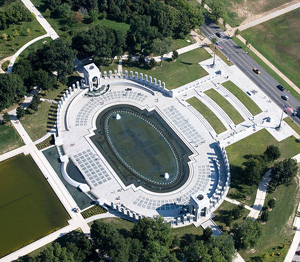In the ongoing debate over whether memorials to commemorate political and military events and leaders should embrace architectural modernism or stick with classicism, several conservative groups have taken a firm stance in favor of classicism.

On May 18, the American Enterprise Institute (AEI), a right-wing think tank focused on public policy, teamed up with the National Civic Art Society (NCAS), an advocacy organization leading the charge against Frank Gehry’s design for an Eisenhower Memorial, to host the forum, “Monumental Fights: The Role of Memorials in Civic Life.” The event in Washington, D.C, which drew about 60 attendees (and was streamed online), featured panelists Bruce Cole of the Hudson Institute, a conservative group in New York; Michael J. Lewis, an art and architecture professor at Williams College; Diana Schaub, a political scientist at Loyola University Maryland; and Roger Scruton, a visiting scholar at AEI.
With almost no dissent among the speakers, the forum was a one-sided attack on non-classical memorials and monuments built in recent decades. The event served as a reminder that certain people will always revile Modernism for both ideological and aesthetic reasons.
There was agreement, for instance, that Maya Lin’s Vietnam Veterans Memorial (1982)—viewed by many Americans as a strong expression of national mourning—is a contemptible failure. Lin’s design, which took the once-unusual step of listing every American casualty by name, “didn’t properly honor the sacrifice” of veterans, asserted Gary Schmitt, director of AEI’s American Citizenship program, during his introduction to the panel discussion.” Scruton asked, rhetorically: “Will it have power in 200 years when Vietnam is just seen as one of many inevitable tragedies of human history?”
The main subject of abuse, however, was the proposed Eisenhower Memorial, which every speaker inveighed against. “Gehry’s design shows unease with his subject’s greatness,” said Lewis. In reference to placing a life-sized statue of Eisenhower as a child in the center of the memorial, Lewis noted: “Martial greatness is not in fashion. Perhaps that’s why Gehry nimbly sidestepped it by making the focus young Ike.” The comments were not up to date, however: On May 15, Gehry’s studio unveiled a revised design that includes large sculptures of Eisenhower as a general and president and a smaller sculpture depicting him as a young man, not a boy.
Many took jabs at Gehry. “I believe it is unlikely, but conceivable, that a Modernist architect could achieve the balance and proportions required of a memorial,” said Cole, former chairman of the National Endowment for the Humanities. “Frank Gehry is a self-conscious rebel architect who has made his fortune on unstable and unfocused buildings, such as the Dancing House in Prague and the Case Western Reserve Law School. Few successful monuments are on this grandiose scale. Gehry’s design has no overall narrative, no core to enlighten the visitor. The whole is less than the sum of its parts; it just doesn’t work.”
The irony, though, is that even when these curmudgeons get what they want, they remain unhappy. The National World War II Memorial (designed by Friedrich St. Florian), which features a fountain encircled by stone columns and a pair of arches, was criticized. So was the new Martin Luther King, Jr. Memorial—a giant stone carving of the civil rights leader by ROMA Design Group and sculptor Lei Yixin. Lewis complained that King is presented as “despot” with a “sneer.”
One audience member questioned whether the “egregious” problem of contemporary memorials failing to “reflect heroism” signals “a lack of self-confidence in America.” Scruton, who is British, said the suggestion was “absolutely right” but noted that it wasn’t exclusively an American problem. He went on to say that his main issue with the Eisenhower Memorial design is that “it doesn’t come from the people; it comes from the overly self-indulgent elite.”
It’s strange for classicists to complain that Gehry’s design is simultaneously too grandiose and lacking in self-confidence. Isn’t building something bold and different the ultimate architectural expression of a society’s self-confidence?

Post a comment to this article
Report Abusive Comment